Dec 20, 2010 | bullion, gold, video
Town Center Mall in Boca Raton, Florida is not a run-of-the-mill shopping plaza. With upscale stores like Neiman Marcus, Bloomindale’s, Nordstrom, and Tiffany and Company, there are plenty of opportunities to overspend this holiday season. Now, you can diversify your portfolio by buying gold… from a vending machine!
PMX Gold LLC, the wholly-owned subsidiary of the mining company PMX Communities Inc. worked with Ex Oriente Lux AG to bring the Gold to go® vending machine to the United States. Installed at the Town Center Mall, the machine will dispense 1 gram, 5 gram, 10 gram, 1 ounce, and 250 gram gold bars from Credit Suisse; 1/10 ounce, 1/4 ounce, and 1 ounce Krugerrands; and 1/10 ounce and 1 ounce American Eagle Gold bullion coins.
Gold is dispensed in a black gift box whose price is based on the current spot price that updates wirelessly every 10 minutes. Customers are guided through their purchases using a touch screen that allows them to select the amount of gold they want to purchase. PMX Gold LLC and Simon Properties, owner of the Town Center Mall, will make money of a commission that ranges between 4 and 15 percent depending on the item’s weight. Currently, the machine only accepts cash, but that may change in the future.
The machine will be guarded by am armed security person and monitored by cameras.
This report was broadcast on WPTV, News Channel 5 in Orlando:
Another video from the Orlando Sentinel:
Gold to Go made news when it installed its first Gold ATM at the Emirates Palace in Abu Dhabi. Currently, there are 11 machines in Germany, one in Spain, Italy, United Arab Emirates, and now the United States. Ex Oriente Lux reports that their machines in Europe take in 250,000 to 300,000 Euros per month.
Thomas Geisslei, CEO of Gold to Go, say that the company wants to install more than 30 machines within the United States in the next year. This way, you can decide whether you want that latte or a gold bar.
Nov 7, 2010 | cents, charity, video
The Coin Collector’s Blog is a proud supporter of Common Cents®, an educational, not-for-profit organization, which specializes in creating and managing service-learning programs for young people. Their most popular and best known program is the . It is largest child philanthropy program in the United States.
This past fiscal year, Common Cents reported that “hundreds of thousands of students who participated in the Penny Harvest program last year, collecting and giving away $756,273.19 to charities.” For those who think the lowly copper-coated zinc cent is worthless, that is over 75 million coins collected by students in Metropolitan New York City, the New York Capital Region, Ohio, Florida, and Seattle to benefit causes around the world. In addition to charitable giving, the many of the students involved in the Penny Harvest participated in “service-learning projects, such as block clean-ups and literacy programs.”
I became interested in Common Cents when the Penny Harvest Field was set up in Rockefeller Center and featured on NBC Nightly News in 2007. Although I was unable to visit New York City to see this in person, it was quite a site on television. A year later after reading their annual report and talking with a teacher who was involved with the Penny Harvest, I made Common Cents the Official Charity of the Coin Collector’s Blog.
To better understand how lives can be touched not only by those receiving the help but by those working to provide the help, I found this video of Savion, a student from P.S. 163 Alfred E. Smith School, a multi-cultural school located on Manhattan’s upper west side.
As we approach the holiday season, I am asking my readers to please consider helping Common Cents with a donation to help them continue with the Penny Harvest. Also, if you live in an area where the Penny Harvest is not located, please consider getting involved and maybe start a Penny Harvest to your area. In fact, sign up for their mailing list and when you answer question 3 at the bottom of the page, click on at least one of the first three options and see if we can get the Penny Harvest working in more locations!
Charity is good for the soul!
Charity supported by children is not only good for the soul but a sign of a positive future for this nation.
Please support Common Cents and the Penny Harvest.
Videos courtesy of Common Cents.
Oct 30, 2010 | currency, history, video
Since 1879, Crane & Co. has been the exclusive currency paper supplier to the Bureau of Engraving and Printing. The company was founded in 1801 by Zenas Crane. Crane, the fourth son of Liberty Paper Mill’s owner Stephen Crane, knew he would not be able to take over the family visit. After learning about paper making, Zenas moved to Dalton, Massachusetts and founded his own mill.
According to CNN Money, Crane & Co. became the supplier of currency paper to the BEP by applying business practices that would not be tolerated today* outbidding other potential bidders:
In May 1879, Zenas’ son, W. Murray Crane was in Washington, D.C., and heard that the Treasury Department was unhappy with their paper currency supplier and was accepting bids for the business.
After all the bids were submitted, Murray learned the amount of the lowest bid and raced back to his hotel room to prepare a second, much lower bid, says Crane historian Peter Hopkins. When the other bidders heard about Crane’s plan they locked him in his room, according to the story, but he managed to slip out and get his bid in just in time. Ever since, Crane & Co. has manufactured the U.S. currency paper.
Today, Crane & Co. is providing the currency paper for the new $100 note with technical features not found on any other note in the world. Interestingly, Crane & Co. is owned and managed by the eighth generation of the Crane family and continues to survive using its currency paper and stationary business.
The following video interviewing Crane & Co. CEO Charles Kittredge about the company’s history and the current economic climate for paper appeared in the Small Business Section of CNNMoney.com:
* CORRECTION: I was contacted by Peter Hopkins, who was quoted in the CNN story. He pointed out to me that while the CNN story may have made the practice of submitting a last minute bid was not exactly ethical, the telegram Murray Crane sent back to Crane & Co. noted that up to three bids could be submitted. Thus, Murray Crane was acting in accordance with the rules while his competitors were not acting professionally. I apologize for the error and corrected the story.
Video courtesy of CNN Money.com
Sep 23, 2010 | national park quarters, US Mint, video
 On September 21, the U.S. Mint had its launch of the Grand Canyon National Park quarter. The event was held near the Verkamp’s Visitor Center at the Grand Canyon National Park. The reverse image features a view of the granaries above the Nankoweap Delta in Marble Canyon near the Colorado River. Marble Canyon is the northernmost section of the Grand Canyon. Granaries were used for storing food and seeds. It was designed and sculpted by United States Mint Sculptor-Engraver Phebe Hemphill.
On September 21, the U.S. Mint had its launch of the Grand Canyon National Park quarter. The event was held near the Verkamp’s Visitor Center at the Grand Canyon National Park. The reverse image features a view of the granaries above the Nankoweap Delta in Marble Canyon near the Colorado River. Marble Canyon is the northernmost section of the Grand Canyon. Granaries were used for storing food and seeds. It was designed and sculpted by United States Mint Sculptor-Engraver Phebe Hemphill.
As with previous releases, the U.S. Mint released an edited B-roll video of the launch with highlights, scenery, production footage.
The Grand Canyon is the first of the quarters that represents a national park I have visited. Looking at the background over his shoulder, I understand why U.S. Mint Director Ed Moy looks happy. Although I have only been to the South Rim, the Grand Canyon is still one of the most awesome sites in the United States and worth visiting.
Quarter image and video complements of the U.S. Mint.
Sep 22, 2010 | BEP, video
As a follow up to their previous video, the Bureau of Engraving and Printing has released Part II of their educational series about the new $100 Federal Reserve Note.
This month’s video is “How to Detect A Counterfeit, Part II.” The 12-minute video shows consumers how to recognize the watermark, security thread, color-shifting ink, raised printing, and microprinting security features on the new note. The video includes a demonstration by Kelley Harris of the United States Secret Service, head of the Washington, DC counterfeit lab. Harris also shows examples of counterfeit attempts. Interestingly, she talks about the small letters and numbers located on the notes that show the plate and position codes of the notes.
Here is the BEP’s video:
UPDATE:
Yesterday’s release announcement was for the third video podcast of the BEP’s $100 Note Podcast series. Rather than read the release, I used the information from other sources. Sorry! The new video is “The Art of the Banknote Design.” The video features Larry Felix, Director of the Bureau of Engraving and Printing, and Michael Lambert, Assistant Director of the Board of Governors of the Federal Reserve System. Felix and Lambert discusses the thoughts behind the creating of the new $100 Federal Reserve Note.
Here’s video three:
Aug 25, 2010 | BEP, fun, video
While surfing around YouTube, I came across an interesting video of a segment of the old television show What’s My Line? In this segment (of Episode #478 airing on August 23, 1959), J.A. Conlon (James A. Conlon), the Assistant Chief of the Currency and Stamp Production department at the Bureau of Engraving and Printing appeared on the show attempting to stump the panel. Watch how he does…
At the end of the segment, Conlon gives the panel members samples of the new 4-cent stamp with multi-color printing. The stamp features the flag with 49 stars since it was designed before Hawai’i became a state and the 50th star that was added to the flag on July 4, 1960.
J.A. Conlon became the Director of the Bureau of Engraving and Printing in 1967 serving until 1977.
Aug 23, 2010 | BEP, currency, video
Last week, the Bureau of Engraving and Printing, Federal Reserve Board, and the U.S. Secret Service jointly announced the next step in educating the public to protect themselves against counterfeit currency with a new video “How to Detect a Counterfeit.” The video was created to demonstrate the security features of the new $100 note.
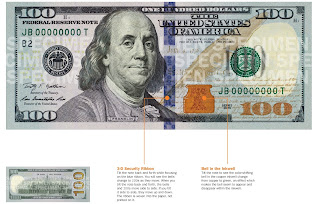 The $100 United States Federal Reserve Note is the most counterfeited currency in the world. To stay ahead of counterfeiters, the BEP redesigned the note with security features designed to prevent digital duplication. In addition to the security thread, color shifting ink, microprinting, and portrait watermark that has appeared on other notes, the new $100 note includes a new 3-D Security Ribbon embedded in the paper and the additional use of color shifting ink by embedding a bell within the inkwell on the front of the note.
The $100 United States Federal Reserve Note is the most counterfeited currency in the world. To stay ahead of counterfeiters, the BEP redesigned the note with security features designed to prevent digital duplication. In addition to the security thread, color shifting ink, microprinting, and portrait watermark that has appeared on other notes, the new $100 note includes a new 3-D Security Ribbon embedded in the paper and the additional use of color shifting ink by embedding a bell within the inkwell on the front of the note.
“In the video, Kelley Harris, U.S. Secret Service Supervisory Counterfeit Specialist, discusses how to identify the security features in the redesigned $100 note, including the new 3-D Security Ribbon and the Bell in the Inkwell. Viewers will also learn about common tricks counterfeiters use to fool businesses and consumers, what businesses and consumers should do if they suspect someone is trying to pass them a counterfeit note, and the U.S. Secret Service’s work to combat counterfeiting operations.”
The video is available to view on the BEP’s New Money website or for download from the multimedia page. You can find it there in case the following stops working:
Multimedia elements courtesy of the U.S. Bureau of Engraving and Printing.
Aug 9, 2010 | coins, national park quarters, US Mint, video
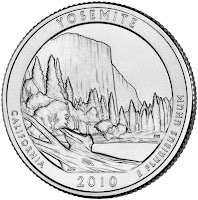 On July 29, 2010, US Mint director Ed Moy introduced the Yosemite National Park Quarter at the park in California. The coin fathers the image of El Capitan, the 3,000-foot vertical rock formation that is prominent formation that looms over Yosemite Valley.
On July 29, 2010, US Mint director Ed Moy introduced the Yosemite National Park Quarter at the park in California. The coin fathers the image of El Capitan, the 3,000-foot vertical rock formation that is prominent formation that looms over Yosemite Valley.
Prior to being discovered by European-Americans in 1833, the Ahwahneechee people inhabited Yosemite Valley. As the gold-rush expanded the non-native population, U.S. troops burned Ahwahneechee villages in 1851, eventually driving them out of the valley. Within a few years, the lack of gold lead to entrepreneurs to use early photographs of the area to turn the area into a tourist destination.
By 1864, the commercial use of the area became a concern. Prominent citizens lobbied congress to pass a bill to declare the area a national park. The bill creating the Yosemite Grand was signed by President Abraham Lincoln on June 30, 1864. Yosemite Grant was managed by the Army until the National Park Service was created in 1916.
A coin exchange and roll sale followed the launch ceremony.
The following video of the launch ceremony was released by the U.S. Mint:
You can find the B-Roll package at NewsInfusion.com.
Coin image courtesy of the U.S. Mint.
Jul 7, 2010 | coins, currency, Euro, foreign, gold, RCM, video
Not all coin news comes from the United States. Here are three interesting non-U.S. stories from the last few weeks:
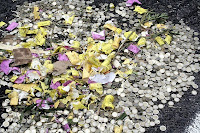 Foggia, Italy—A truck in southern Italy carrying €2 million in one and two euro coins crashed and spilled its load on the highway. Feeling they hit the jackpot, drivers stopped and started to scoop up the coins. On the scene, it was estimated that €10,000 was taken. A later count upped that estimate to €50,000. No arrests were reported.
Foggia, Italy—A truck in southern Italy carrying €2 million in one and two euro coins crashed and spilled its load on the highway. Feeling they hit the jackpot, drivers stopped and started to scoop up the coins. On the scene, it was estimated that €10,000 was taken. A later count upped that estimate to €50,000. No arrests were reported.
Driver of the truck and the two cars in the accident were not seriously injured, but they were not the focus of many of the stories. With coins strewn on the roadway and the median, the company responsible for the transport of the coins will be spending the next few days trying to sweep up the coins that motorists did not take.
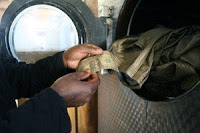 Zimbabwe—In a country where runaway inflation caused their currency to become worthless and the government made U.S. currency legal tender, Zimbabweans are washing their U.S. dollars so that they can be used.
Zimbabwe—In a country where runaway inflation caused their currency to become worthless and the government made U.S. currency legal tender, Zimbabweans are washing their U.S. dollars so that they can be used.
In this poor country, low-denomination U.S notes are used until they fall apart. But in order to protect currency in crime-ridden areas, notes are carried in shoes or underwear. The obvious sanitary and malodorous issues has made it a problem causing banks and many merchants to refuse to take currency that is dirty and smelly. Some people gently hand-wash their notes and some laundry services have discovered that they can wash notes in the gentle cycle then hang the notes to dry.
Apparently this works for the poor in Zimbabwe since the notes outlive the Bureau of Engraving and Printing’s estimated life span of a $1 Federal Reserve Note of 20-months.
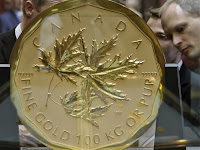 Vienna—Spanish gold dealer Oro Direct S.L.U. bought the world’s largest gold coin at auction for &euro3.27 million (approximately $4.02 million). The 100 kilogram coin with a face value of C$1 million was made by the Royal Canadian Mint in 2007. This coin currently holds the world’s record for being the largest coin ever made.
Vienna—Spanish gold dealer Oro Direct S.L.U. bought the world’s largest gold coin at auction for &euro3.27 million (approximately $4.02 million). The 100 kilogram coin with a face value of C$1 million was made by the Royal Canadian Mint in 2007. This coin currently holds the world’s record for being the largest coin ever made.
Gold was trading at $1,253.55 per troy ounce in London at the time of the auction.
“We believe that this is a way to demonstrate our opinion that gold is the ultimate store of wealth,” Oro Direct spokesman Michael Berger was reported as saying. “As long as central banks continue to print enormous amounts of paper money, we believe physical gold will be a fantastic investment.”
The following news video is from Reuters:
About the coin in a video by the Royal Canadian Mint:
Images from Italy and Zimbabwe are courtesy of the AP.
Image of the C$1 Million Maple Leaf courtesy of Reuters.
Jun 3, 2010 | coins, national park quarters, US Mint, video
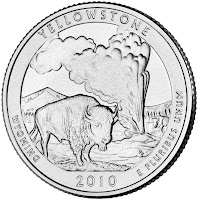 While the U.S. Mint fights trademark issues over the name of their program, Director and professional politician Ed Moy travelled to Yellowstone National Park in Wyoming today to launch the Yellowstone National Park Quarter. Moy was joined by Suzanne Lewis, Superintendent of Yellowstone National Park.
While the U.S. Mint fights trademark issues over the name of their program, Director and professional politician Ed Moy travelled to Yellowstone National Park in Wyoming today to launch the Yellowstone National Park Quarter. Moy was joined by Suzanne Lewis, Superintendent of Yellowstone National Park.
Yellowstone National Park was established by an act of congress on March 1, 1872. Its 2.2 million acres is home to grizzly bears, elk, wolves, and bison. Along with the Old Faithful Geyser are a collection of an extraordinary group of geysers that do not receive the same press as Old Faithful.
The reverse of the coin features Old Faithful Geyser and a bison, both excellent representatives of the nation’s second National Park.
Here is the B-roll video from the U.S. Mint and the launch ceremony:
Quarter image Courtesy of the U.S. Mint







